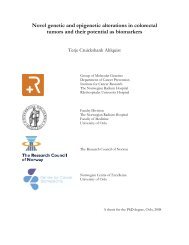Preface - Ous-research.no
Preface - Ous-research.no
Preface - Ous-research.no
You also want an ePaper? Increase the reach of your titles
YUMPU automatically turns print PDFs into web optimized ePapers that Google loves.
Transplantation and Malignancy<br />
1.6 Tumor gene expression profiles will be determined in<br />
metastases and in <strong>no</strong>rmal liver tissue (oligonucleotide micro<br />
array analysis)<br />
1.7 Proteome profiles will be assessed. Clinical proteomics<br />
is a field which has been reported to have high sensitivity<br />
and specificities for early detection of several solid tumors,<br />
and is promising in the search for <strong>no</strong>vel biomarkers in CRC.<br />
Analyses of the proteomic profiles will be performed by<br />
MALDI-TOF mass spectrometry and peptide sequencing<br />
using linear ion trap mass spectrometry (q-Trap).<br />
1.8 DNA-Ploidy pattern and chromosomal instability will<br />
be assessed by flow cytomtery complemented by image<br />
analytic techniques. Ab<strong>no</strong>rmalities in DNA content (aneuploidy)<br />
have been independently associated with adverse<br />
prog<strong>no</strong>sis in CRC. Analyses of microsatelite stability and<br />
chromosomal instability will be performed as these factors<br />
also have shown to be of prog<strong>no</strong>stic value.<br />
1.9 The role of disseminated tumor cells ((DTC, micro<br />
metastases). The prog<strong>no</strong>stic value of disseminated tumor<br />
cells in bone marrow (BM) has been investigated in several<br />
studies comprising patients with epithelial cancers such as<br />
breast-, colorectal- and gastric cancer. The presence of DTC<br />
in BM seems to be of predictive value for the development<br />
of metastases <strong>no</strong>t only in bones but also in other distant<br />
organs even in tumors that rarely develop skeletal metastases<br />
such CRC. Concerning breast cancer it has been shown<br />
that the detection of disseminated tumors cells in bone<br />
marrow by immu<strong>no</strong>cythochemical methods is a strong<br />
and independent prog<strong>no</strong>stic factor. Although <strong>no</strong>t completely<br />
unequivocal, possibly because of a certain degree<br />
of methodological concern and lack of standardization,<br />
identification of DTC in BM also seems to predict disease<br />
free survival for patients with CRC. The incidence of DTC in<br />
BM in patients with isolated liver metastases from CRC is low<br />
when compared to patients with primary CRC or disseminated<br />
CRC disease, but their presence is associated with a poor<br />
prog<strong>no</strong>sis. There is strong evidence, at least from breast<br />
cancer that DTC in the peripheral blood from patients with<br />
N0 disease is correlated with a high incidence of systemic<br />
relapse and mortality. In CRC the inconsistency of detection<br />
is larger and a more standardized methodology and sets of<br />
markers are called for. Nevertheless, it is probable that such<br />
a correlation will be found using a combination of markers.<br />
Little is k<strong>no</strong>wn about the molecular characteristics of<br />
isolated DTC cells. Recent tech<strong>no</strong>logical advances involving<br />
enrichment of the relevant cell population, amplification<br />
procedures for DNA and RNA as well as high-throughput<br />
molecular screening tools <strong>no</strong>w render such characterization<br />
feasible. Samples containing from DTCs in BM, systemic-<br />
and portal blood give the possibility to compare molecular<br />
characteristics of cells from these compartments with each<br />
other and with the hepatic metastatic tissue. A <strong>no</strong>vel aspect<br />
is that peripheral blood is collected for DTCs at Ltx, both at<br />
induction of anaesthesia and after manipulation of the liver<br />
in order to assess the potential effect of manipulation of the<br />
liver. Samples from BM, portal- and systemic blood will be<br />
processed at the Department of Tumor Biology immediately<br />
after sampling, using standard procedures for mo<strong>no</strong>nuclear<br />
cell isolation i.e. immu<strong>no</strong>bead rosetting and preparation of<br />
cytospins for immu<strong>no</strong>cythochemical analysis. Tumor cells<br />
isolated by immu<strong>no</strong>bead rosetting will be further enriched<br />
using the CellPick system followed by RNA/DNA isolation<br />
and molecular profiling.<br />
Project 2 Mechanisms of regulatory T cell immune suppression<br />
and characterization of the regulatory T cell –<br />
effector T cell interaction in vitro, with special emphasis<br />
on the potential of cytostatic drugs as immu<strong>no</strong>suppressants<br />
in SECA-patients and in transplanted patients with<br />
de <strong>no</strong>vo malignancy.<br />
The concept of transplantation of cancer patients raises<br />
several immu<strong>no</strong>logic considerations. 1) Immu<strong>no</strong>suppressive<br />
treatment to prevent rejection may promote cancer recurrence.<br />
2) High tumorload in the liver may lead to a relative<br />
immune suppression that possibly involves regulatory T<br />
cells (TR cells), thus the patients may need less intense immu<strong>no</strong>suppressive<br />
treatment than liver transplant recipients<br />
treated on other indications. 3) Cytostatic drugs with immu<strong>no</strong>suppressive<br />
effects may be an alternative to standard<br />
immu<strong>no</strong>suppressive treatment for the SECA patients.<br />
1.1 The role of regulatory T cells in cancer immunity in SECA<br />
patients. Regulatory T cells have been shown to inhibit<br />
anti-tumor immune responses in various studies in patients<br />
with malignant diseases such as colorectal cancer, ovarian<br />
cancer, breast cancer and mela<strong>no</strong>ma. In this project we<br />
aim to investigate the suppressive role of regulatory T cells<br />
in anti-tumor immune function in the SECA patients. This<br />
cohort of patients will be compared to patients with lower<br />
tumor burden and who are eligible for local liver resection<br />
(the Ullevål patient cohort). Anti-tumor immune function<br />
will be evaluated i) prior to transplantation; ii) four months<br />
after; iii) one year after transplantation and; iv) at the time of<br />
recurrence.<br />
1.2 Identification of down-stream cell-signaling pathways<br />
involved in TR cell function. As a part of a broader strategy<br />
to test k<strong>no</strong>wn anti-cancer drugs with immu<strong>no</strong>suppressive<br />
effects to prevent rejection and reduce risk of recurrence in<br />
the SECA-patients, we wish to assess the effects of k<strong>no</strong>wn<br />
45
















